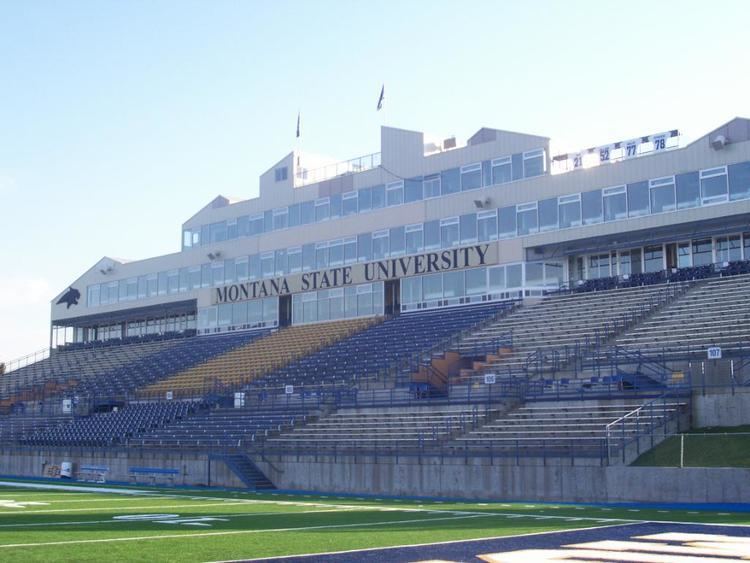Capacity 17,777 Phone +1 406-994-4221 | Opened 1973 | |
 | ||
Former names Reno H. Sales Stadium(1973–1997) Location Montana State University1 Bobcat CircleBozeman, Montana Record attendance 21,527(November 23, 2013) Address 1 Bobcat Cir, Bozeman, MT 59718, USA Similar Worthington Arena, Washington–Grizzly Stadium, Museum of the Rockies, Rocky Mountains, Eccles Coliseum | ||
Bobcat Stadium is an outdoor athletic stadium in the western United States, located on the campus of Montana State University in Bozeman, Montana. It is the home of the Montana State Bobcats college football team of the Big Sky Conference. At the south end of campus, the stadium has a seating capacity of 17,777 and a NW-SE configuration, with the press box along the southwest sideline. Originally natural grass, the playing field was switched to FieldTurf in 2008 and is at an elevation of 4,940 feet (1,510 m) above sea level.
Contents
Reno H. Sales Stadium
The stadium opened in 1973 as Reno H. Sales Stadium, built for about $500,000. Reno Sales (1876–1969) was a lineman on the first Bobcat football team in 1897 and was the college's only graduate in 1898. Later in life he was an engineer and philanthropist. Born in Iowa, Sales moved with his family as a youngster to Montana in 1881 and they homesteaded near Salesville (now Gallatin Gateway); he was the chief geologist for Anaconda Copper for 41 years. During his long life, Mr. Sales was widely known as "Mr. Bobcat," and for his generosity and devotion to his alma mater.
Bobcat Stadium
Prior to the 1998 season, the stadium was renovated for about $12 million and renamed "Bobcat Stadium." The facility was designed to accommodate further expansion in the southeast end zone.
On October 6, 2010, the university was granted approval by the board of regents to proceed with the planning, design and eventual construction of new endzone seating and related enhancements to Bobcat Stadium. Some of the enhancements include new visiting team and referee locker rooms, restrooms, an 18-by-37-foot (5.5 m × 11.3 m) LED video board in the north end zone, and a new scoreboard atop the new section. The new 7,200-seat end zone "bowl" connects the two sideline grand stands. The renovation was projected to cost $8–10 million; $4 million was required to be raised privately with the remaining amount to be financed and paid for through ticket and other athletics related revenue. No new student fees or other public money was to be used for the project. A day before the project was presented to the board of regents, it was an announced that an anonymous individual donated $1 million to the project in honor of former Bobcat legend Sonny Holland.
Ground was broken for the expansion on January 28, 2011, and the work was completed in time for the home opener against UC Davis on September 10.
The upgraded stadium has 17,777 seats, but capacity is routinely expanded through the use of standing room only areas and temporary bleachers in the north endzone. An attendance record of 20,767 was established during the 2012 season opener vs. Chadron State on August 30. Bobcat Stadium set a new record with 21,007 at the 2013 season opener against Monmouth on August 29. The venue was further enhanced with floodlights through the use of donations obtained in the fall of 2011. Since 2012, MSU has had the capability to host night games and meet television broadcasting lighting requirements.
Gatton Field
Through the 1971 football season, the Bobcats played home games for four decades at Gatton Field. It was located directly south of the Romney Gym, across Grant Street and northeast of the Brick Breeden Fieldhouse, which opened in 1957. The playing field ran east-west and had lighting as far back as the 1940s. (photos) It was razed in early 1972 and is the site of the Marga Hosaeus Fitness Center, opened in 1973. Bobcat Stadium is approximately a half mile (800 m) due south.
The field was named for Cyrus J. Gatton (1894–1918), a former Montana State football player from 1913–1916. Born in Iowa and raised in Bozeman, Gatton enlisted in the U.S. Army Air Service during World War I and was killed in northeast France while flying for the 11th Aero Squadron on November 4, just a week before the Armistice. The class of 1917 voted in 1920 that when the school built a new football field it should be named for Cyrus Gatton, and the request was honored ten years later.
Van Winkle Stadium
The new stadium was not completed for the 1972 season; the Bobcats played their home games at Van Winkle Stadium at Bozeman High School, with expanded temporary seating. Despite the change of venue, MSU lost just one home game, won the Big Sky title (5–1), and finished 8–3 overall.
